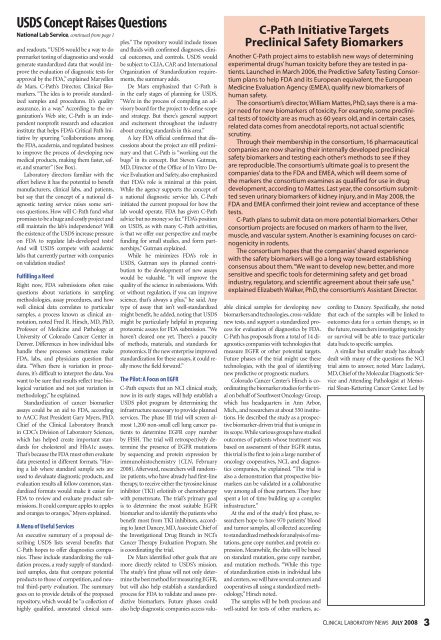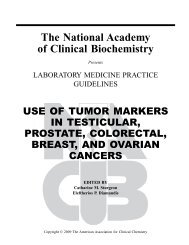Clinical Laboratory News - American Association for Clinical ...
Clinical Laboratory News - American Association for Clinical ...
Clinical Laboratory News - American Association for Clinical ...
Create successful ePaper yourself
Turn your PDF publications into a flip-book with our unique Google optimized e-Paper software.
USDS Concept Raises Questions<br />
national lab service, continued from page 1<br />
and readouts. “USDS would be a way to do<br />
premarket testing of diagnostics and would<br />
generate standardized data that would improve<br />
the evaluation of diagnostic tests <strong>for</strong><br />
approval by the FDA,” explained Maryellen<br />
de Mars, C-Path’s Director, <strong>Clinical</strong> Biomarkers.<br />
“The idea is to provide standardized<br />
samples and procedures. It’s quality<br />
assurance, in a way.” According to the organization’s<br />
Web site, C-Path is an independent<br />
nonprofit research and education<br />
institute that helps FDA’s Critical Path Initiative<br />
by spurring “collaborations among<br />
the FDA, academia, and regulated business<br />
to improve the process of developing new<br />
medical products, making them faster, safer,<br />
and smarter” (See Box).<br />
<strong>Laboratory</strong> directors familiar with the<br />
ef<strong>for</strong>t believe it has the potential to benefit<br />
manufacturers, clinical labs, and patients,<br />
but say that the concept of a national diagnostic<br />
testing service raises some serious<br />
questions. How will C-Path fund what<br />
promises to be a huge and costly project and<br />
still maintain the lab’s independence? Will<br />
the existence of the USDS increase pressure<br />
on FDA to regulate lab-developed tests?<br />
And will USDS compete with academic<br />
labs that currently partner with companies<br />
on validation studies?<br />
Fulfilling a Need<br />
Right now, FDA submissions often raise<br />
questions about variations in sampling<br />
methodologies, assay procedures, and how<br />
well clinical data correlates to particular<br />
samples, a process known as clinical annotation,<br />
noted Fred R. Hirsch, MD, PhD,<br />
Professor of Medicine and Pathology at<br />
University of Colorado Cancer Center in<br />
Denver. Differences in how individual labs<br />
handle these processes sometimes make<br />
FDA, labs, and physicians question that<br />
data. “When there is variation in procedures,<br />
it’s difficult to interpret the data. You<br />
want to be sure that results reflect true biological<br />
variation and not just variation in<br />
methodology,” he explained.<br />
Standardization of cancer biomarker<br />
assays could be an aid to FDA, according<br />
to AACC Past President Gary Myers, PhD,<br />
Chief of the <strong>Clinical</strong> <strong>Laboratory</strong> Branch<br />
in CDC’s Division of <strong>Laboratory</strong> Sciences,<br />
which has helped create important standards<br />
<strong>for</strong> cholesterol and HbA1c assays.<br />
That’s because the FDA must often evaluate<br />
data presented in different <strong>for</strong>mats. “Having<br />
a lab where standard sample sets are<br />
used to devaluate diagnostic products, and<br />
evaluation results all follow common, standardized<br />
<strong>for</strong>mats would make it easier <strong>for</strong><br />
FDA to review and evaluate product submissions.<br />
It could compare apples to apples<br />
and oranges to oranges,” Myers explained.<br />
A Menu of Useful Services<br />
An executive summary of a proposal describing<br />
USDS lists several benefits that<br />
C-Path hopes to offer diagnostics companies.<br />
These include standardizing the validation<br />
process, a ready supply of standardized<br />
samples, data that compare potential<br />
products to those of competition, and neutral<br />
third-party evaluation. The summary<br />
goes on to provide details of the proposed<br />
repository, which would be “a collection of<br />
highly qualified, annotated clinical sam-<br />
ples.” The repository would include tissues<br />
and fluids with confirmed diagnoses, clinical<br />
outcomes, and controls. USDS would<br />
be subject to CLIA, CAP, and International<br />
Organization of Standardization requirements,<br />
the summary adds.<br />
De Mars emphasized that C-Path is<br />
in the early stages of planning <strong>for</strong> USDS.<br />
“We’re in the process of compiling an advisory<br />
board <strong>for</strong> the project to define scope<br />
and strategy. But there’s general support<br />
and excitement throughout the industry<br />
about creating standards in this area.”<br />
A key FDA official confirmed that discussions<br />
about the project are still preliminary<br />
and that C-Path is “working out the<br />
bugs” in its concept. But Steven Gutman,<br />
MD, Director of the Office of In Vitro Device<br />
Evaluation and Safety, also emphasized<br />
that FDA’s role is minimal at this point.<br />
While the agency supports the concept of<br />
a national diagnostic service lab, C-Path<br />
initiated the current proposal <strong>for</strong> how the<br />
lab would operate. FDA has given C-Path<br />
advice but no money so far. “FDA’s position<br />
on USDS, as with many C-Path activities,<br />
is that we offer our perspective and maybe<br />
funding <strong>for</strong> small studies, and <strong>for</strong>m partnerships,”<br />
Gutman explained.<br />
While he minimizes FDA’s role in<br />
USDS, Gutman says its planned contribution<br />
to the development of new assays<br />
would be valuable. “It will improve the<br />
quality of the science in submissions. With<br />
or without regulation, if you can improve<br />
science, that’s always a plus,” he said. Any<br />
type of assay that isn’t well-standardized<br />
might benefit, he added, noting that USDS<br />
might be particularly helpful in preparing<br />
proteomic assays <strong>for</strong> FDA submission. “We<br />
haven’t cleared one yet. There’s a paucity<br />
of methods, materials, and standards <strong>for</strong><br />
proteomics. If the new enterprise improved<br />
standardization <strong>for</strong> these assays, it could really<br />
move the field <strong>for</strong>ward.”<br />
The Pilot: A Focus on EGFR<br />
C-Path expects that an NCI clinical study,<br />
now in its early stages, will help establish a<br />
USDS pilot program by determining the<br />
infrastructure necessary to provide planned<br />
services. The phase III trial will screen almost<br />
1,200 non-small cell lung cancer patients<br />
to determine EGFR copy number<br />
by FISH. The trial will retrospectively determine<br />
the presence of EGFR mutations<br />
by sequencing and protein expression by<br />
immunohistochemistry (CLN, February<br />
2008). Afterward, researchers will randomize<br />
patients, who have already had first-line<br />
therapy, to receive either the tyrosine kinase<br />
inhibitor (TKI) erlotinib or chemotherapy<br />
with pemetrexate. The trial’s primary goal<br />
is to determine the most suitable EGFR<br />
biomarker and to identify the patients who<br />
benefit most from TKI inhibitors, according<br />
to Janet Dancey, MD, Associate Chief of<br />
the Investigational Drug Branch in NCI’s<br />
Cancer Therapy Evaluation Program. She<br />
is coordinating the trial.<br />
De Mars identified other goals that are<br />
more directly related to USDS’s mission.<br />
The study’s first phase will not only determine<br />
the best method <strong>for</strong> measuring EGFR,<br />
but will also help establish a standardized<br />
process <strong>for</strong> FDA to validate and assess predictive<br />
biomarkers. Future phases could<br />
also help diagnostic companies access valu-<br />
c-path initiative Targets<br />
preclinical safety biomarkers<br />
another C-path project aims to establish new ways of determining<br />
experimental drugs’ human toxicity be<strong>for</strong>e they are tested in patients.<br />
launched in March 2006, the predictive safety testing Consortium<br />
plans to help fda and its european equivalent, the european<br />
Medicine evaluation agency (eMea), qualify new biomarkers of<br />
human safety.<br />
the consortium’s director, william Mattes, phd, says there is a major<br />
need <strong>for</strong> new biomarkers of toxicity. <strong>for</strong> example, some preclinical<br />
tests of toxicity are as much as 60 years old, and in certain cases,<br />
related data comes from anecdotal reports, not actual scientific<br />
scrutiny.<br />
through their membership in the consortium, 16 pharmaceutical<br />
companies are now sharing their internally developed preclinical<br />
safety biomarkers and testing each other’s methods to see if they<br />
are reproducible. the consortium’s ultimate goal is to present the<br />
companies’ data to the fda and eMea, which will deem some of<br />
the markers the consortium examines as qualified <strong>for</strong> use in drug<br />
development, according to Mattes. last year, the consortium submitted<br />
seven urinary biomarkers of kidney injury, and in May 2008, the<br />
fda and eMea confirmed their joint review and acceptance of these<br />
tests.<br />
C-path plans to submit data on more potential biomarkers. other<br />
consortium projects are focused on markers of harm to the liver,<br />
muscle, and vascular system. another is examining focuses on carcinogenicity<br />
in rodents.<br />
the consortium hopes that the companies’ shared experience<br />
with the safety biomarkers will go a long way toward establishing<br />
consensus about them. “we want to develop new, better, and more<br />
sensitive and specific tools <strong>for</strong> determining safety and get broad<br />
industry, regulatory, and scientific agreement about their safe use,”<br />
explained elizabeth walker, phd, the consortium’s assistant director.<br />
able clinical samples <strong>for</strong> developing new<br />
biomarkers and technologies, cross-validate<br />
new tests, and support a standardized process<br />
<strong>for</strong> evaluation of diagnostics by FDA.<br />
C-Path has proposals from a total of 14 diagnostics<br />
companies with technologies that<br />
measure EGFR or other potential targets.<br />
Future phases of the trial might use these<br />
technologies, with the goal of identifying<br />
new predictive or prognostic markers.<br />
Colorado Cancer Center’s Hirsch is coordinating<br />
the biomarker studies <strong>for</strong> the trial<br />
on behalf of Southwest Oncology Group,<br />
which has headquarters in Ann Arbor,<br />
Mich., and researchers at about 550 institutions.<br />
He described the study as a prospective<br />
biomarker-driven trial that is unique in<br />
its scope. While various groups have studied<br />
outcomes of patients whose treatment was<br />
based on assessment of their EGFR status,<br />
this trial is the first to join a large number of<br />
oncology cooperatives, NCI, and diagnostics<br />
companies, he explained. “The trial is<br />
also a demonstration that prospective biomarkers<br />
can be validated in a collaborative<br />
way among all of these partners. They have<br />
spent a lot of time building up a complex<br />
infrastructure.”<br />
At the end of the study’s first phase, researchers<br />
hope to have 970 patients’ blood<br />
and tumor samples, all collected according<br />
to standardized methods <strong>for</strong> analysis of mutations,<br />
gene copy number, and protein expression.<br />
Meanwhile, the data will be based<br />
on standard mutation, gene copy number,<br />
and mutation methods. “While this type<br />
of standardization exists in individual labs<br />
and centers, we will have several centers and<br />
cooperatives all using a standardized methodology,”<br />
Hirsch noted.<br />
The samples will be both precious and<br />
well-suited <strong>for</strong> tests of other markers, ac-<br />
cording to Dancey. Specifically, she noted<br />
that each of the samples will be linked to<br />
outcomes data <strong>for</strong> a certain therapy, so in<br />
the future, researchers investigating toxicity<br />
or survival will be able to trace particular<br />
data back to specific samples.<br />
A similar but smaller study has already<br />
dealt with many of the questions the NCI<br />
trial aims to answer, noted Marc Ladanyi,<br />
MD, Chief of the Molecular Diagnostic Service<br />
and Attending Pathologist at Memorial<br />
Sloan-Kettering Cancer Center. Led by<br />
CliniCal laboratory news JuLy 2008 3
















